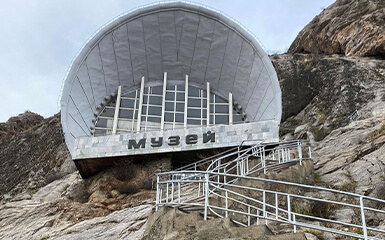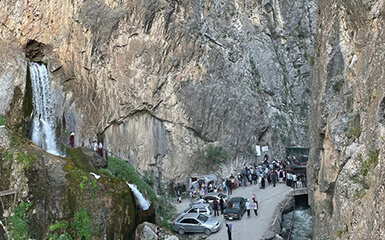The trade city of Osh has a history of nearly 3000 years and played an important role along the Silk Road.
The Russian Empire conquered Osh in 1876 during the disintegration and annexation of the Central Asian Khanates, and since then it has belonged to the Tsarist Empire and the Soviet Union. The city has belonged to Kyrgyzstan since the end of the Soviet Union in 1991.
The city's great market was one of the largest on the Silk Road in ancient times; its current name "Great Silk Road Bazaar" is a reminder of its historical importance.
Since 1939, Osh has been the administrative centre of the region (Oblast) of the same name, and since 2000 the so-called "second capital" of Kyrgyzstan.
During the collapse of the Soviet Union in 1990, bloody clashes broke out between Kyrgyz and Uzbeks in Osh and the neighbouring town of Uzgen. Tensions between Uzbeks and Kyrgyz again led to clashes in June 2010, at least 117 people died and more than 1,400 people were injured. Between 32,000 and 80,000 people fled to neighbouring Uzbekistan. The city has several monuments, including one of the few remaining statues of Vladimir Lenin and the largest mosque in the country (next to the bazaar).
Looming over the city, Suleiman mountain is filled with ancient places of worship, some of which are still in use and date back several thousand years. It is considered the most complete example of the Central Asian holy mountain and accordingly inscribed as a UNESCO World Heritage Site. A cave in the mountain is the location of a museum with a collection of archaeological, geological and historical finds and information about local flora and fauna. In addition, at the other end of the ledge is a very compact mosque/shrine tucked into the mountain called the Dom Babura Mosque. Overall, it is a good place to take a walk and take in the scenery.
Ravat Abdullakhan Mosque is said to be the oldest mosque in Osh, a tribute to the 16th century Rabat Abdul Khan. Non-Muslims are most likely not allowed to enter.
Turgunbay Sadykov Osh Regional Museum of Fine Arts under Babur Namey mausoleum on the northeast side. Basic collection of Soviet realist works along with some regional Kyrgyz works.
Asaf ibn Burkhiy Mausoleum at the foot of Suleiman Mountain, interesting Islamic architecture named after King Solomon's vizier.
Osh New Mosque is a mosque that you can see before climbing Suleiman Mountain and consists of sculptures that attract attention with its blue mosaic tiles. Tourists are not really allowed inside.
Other must see places in the city are Lenin Statue, Park of Mother's Tears with several statues, Russian Orthodox Church, Statue of Alymbek Datka, Manas statue. Natural monument you can reach easily from Osh are Abshyr-Ata Waterfall, Alai Valley, Kyrgyz Ata National Park and Kara Koy.


